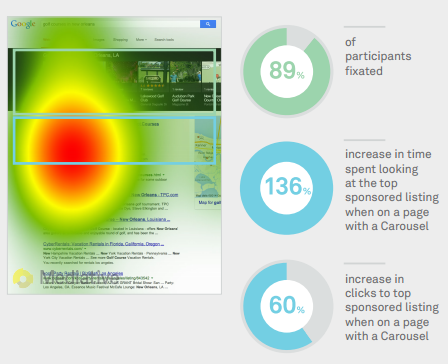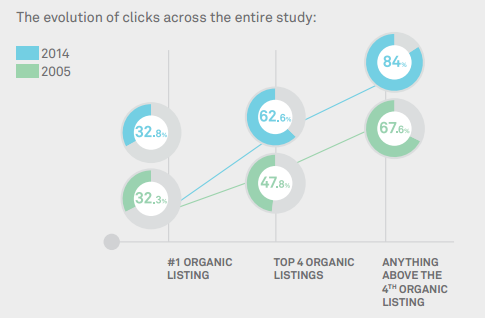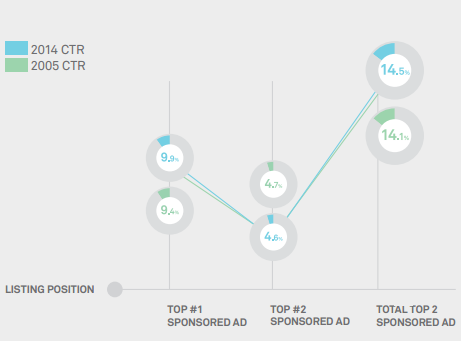I am a huge fan of all research showing how technology is affecting consumer habits, preferences and consumption of content online. Having witnessed how women adapted to the internet at Women.com and later doing research with a client around how different generations of women use smartphones and mobile, this is a fascinating story still unfolding.
Mediative recently released their study examining how consumers have changed their search behavior in reaction to the changes in Google’s algorithm over the last decade. Mediative used eyetracking studies with a panel of 53 consumers to evaluate how consumers reacted to the more complex display of organic search results we see today incorporating Knowledge Graph, Carousel, image-laden and Map organic links. They looked at a variety of behaviors when consumers were presented with Search Engine Ranking Positions (SERPS) for a series of test searches and compared this to eyetracking and click data they had collected on SERP behavior in 2005.
Key takeaways from their study:
- Consumer’s visual search area has broadened from the ”Golden Triangle” pattern typical in 2005 (first reported by Enquiro in “Google Eye Tracking Report: How Searchers See and Click on Google Search Results”) which concentrated attention on the upper left search results (1-3) to now encompass a more vertical, scrolling consumption pattern, drawing search attention down the page to a broader number of search listings:
- Consumers are viewing more search results per session/search, however are spending less time on each search (2 seconds in 2005 has become 1.17 seconds in 2014).
- The much more visual nature of search results may be providing more information to consumers “before the click”, negating the need to click in some cases as the search results are displayed in the SERPs themselves (e.g. from Knowledge Graph listings):
- Interestingly, the “Carousel” feature showing local businesses does not appear to be used much by consumers who continue to focus their attention on the top organic listing when the Carousel is featured in the SERPs:
- The good news for many businesses is that getting into the first 4 organic listings is now likely to generate a significant amount of organic traffic with the proportion of clicks going to the top 4 listings increasing from 47% in 2005 to 63% in 2014:
- The bad news is that only 1% of clicks now go to page 2 of the search results. Ugh!
- Sponsored ad click throughs (despite all the changes in organic search items) show virtually identical click through potential for the top 2 positions comparing 2005 to 2014:
- Finally, the ability for sponsored pay-per-click ads to enhance overall clickthroughs when presented in combination with organic results can’t be overlooked. While less overall attention is being paid to the right-side sponsored ads overall when comparing 2005 to 2014, the branding benefits from getting seen by consumers who are unfamiliar with you combined with the enhanced click through potential of the top 2 sponsored ad positions continues to argue for this highly efficient advertising strategy.
We can’t wait to flash forward to the next decade and wonder how we will all have evolved our search behaviors by 2024…






